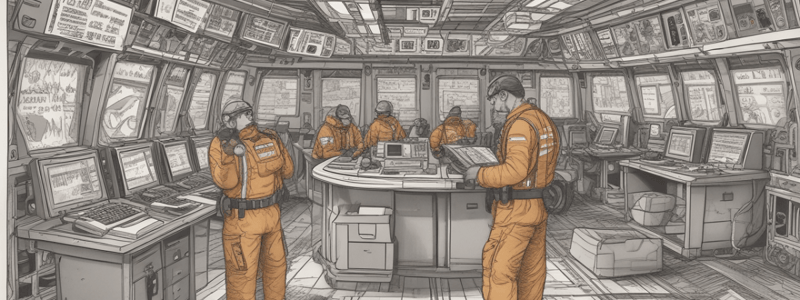Podcast
Questions and Answers
How will the transfer of command be declared?
How will the transfer of command be declared?
- Via a written notification
- Via dispatch radio communications (correct)
- Via a phone call to the supervisor
- Via a personal meeting with the supervisor
What is the minimum number of radio channels designated for incidents requiring the Incident Command System?
What is the minimum number of radio channels designated for incidents requiring the Incident Command System?
- Five
- Two
- Four
- Three (correct)
What system should be used for situation reports over the radio?
What system should be used for situation reports over the radio?
- S.A.F.E Report method
- Tactical Alert Protocol
- 10-Code System
- C.A.N Report method (correct)
When can the transfer of command occur?
When can the transfer of command occur?
What is the first critical task of the first arriving Deputy?
What is the first critical task of the first arriving Deputy?
What is the purpose of the Tactical Alert Protocol?
What is the purpose of the Tactical Alert Protocol?
What should responding units do to keep the Tactical and Operations channels clear?
What should responding units do to keep the Tactical and Operations channels clear?
What is the second critical task of the first arriving Deputy?
What is the second critical task of the first arriving Deputy?
What is the first task of the First On-Scene Supervisor?
What is the first task of the First On-Scene Supervisor?
What is the purpose of the Incident Scribe?
What is the purpose of the Incident Scribe?
What is the typical designation of the Staging Area Manager?
What is the typical designation of the Staging Area Manager?
How many radio channels should be obtained for the incident as needed?
How many radio channels should be obtained for the incident as needed?
What is the purpose of the 'Tactical Alert Protocol'?
What is the purpose of the 'Tactical Alert Protocol'?
What is the importance of the Incident Command Post (ICP)?
What is the importance of the Incident Command Post (ICP)?
What is the purpose of the Inner Perimeter and Outer Perimeter?
What is the purpose of the Inner Perimeter and Outer Perimeter?
Who assumes command of the incident if deemed appropriate?
Who assumes command of the incident if deemed appropriate?
What is the primary purpose of the perimeter in an emergency incident area?
What is the primary purpose of the perimeter in an emergency incident area?
What is the preferred location for the ICP in a short-term incident?
What is the preferred location for the ICP in a short-term incident?
What is the purpose of the staging area in an emergency incident?
What is the purpose of the staging area in an emergency incident?
What should be considered when establishing the ICP for a long-term incident?
What should be considered when establishing the ICP for a long-term incident?
Where should the staging area be established?
Where should the staging area be established?
What is a preferred feature of an ICP for a long-term incident?
What is a preferred feature of an ICP for a long-term incident?
What is the purpose of the inner perimeter?
What is the purpose of the inner perimeter?
What is a characteristic of a unified ICP?
What is a characteristic of a unified ICP?
What is the primary purpose of unified command?
What is the primary purpose of unified command?
When should the Incident Command System (ICS) be implemented and executed?
When should the Incident Command System (ICS) be implemented and executed?
Who has complete authority and responsibility for conducting field operations during an incident?
Who has complete authority and responsibility for conducting field operations during an incident?
What should a ranking senior officer do when they arrive at the scene of an incident?
What should a ranking senior officer do when they arrive at the scene of an incident?
Who assumes the role and responsibility of the Incident Commander (IC) until properly relieved?
Who assumes the role and responsibility of the Incident Commander (IC) until properly relieved?
What should the first arriving deputy do when they arrive at the scene of an incident?
What should the first arriving deputy do when they arrive at the scene of an incident?
What happens to the command structure when a higher-ranking supervisor arrives on scene?
What happens to the command structure when a higher-ranking supervisor arrives on scene?
What is one of the conditions that require the use of Incident Command System (ICS) operational protocols and procedures?
What is one of the conditions that require the use of Incident Command System (ICS) operational protocols and procedures?
Who assumes the duties of the Staging Area Manager?
Who assumes the duties of the Staging Area Manager?
What is the primary consideration for locating the Media Staging Area?
What is the primary consideration for locating the Media Staging Area?
What is the role of the Division or Group Supervisor?
What is the role of the Division or Group Supervisor?
What is the purpose of establishing a staging area?
What is the purpose of establishing a staging area?
Who notifies dispatch of the staging area location?
Who notifies dispatch of the staging area location?
What is the minimum rank required to assume the duties of the Staging Area Manager?
What is the minimum rank required to assume the duties of the Staging Area Manager?
What is the purpose of the Division or Group Supervisor?
What is the purpose of the Division or Group Supervisor?
What is the criteria for selecting a location for the Media Staging Area?
What is the criteria for selecting a location for the Media Staging Area?
Study Notes
Unified Command and Incident Command System
- Unified command is a way to carry out command where responding agencies and/or jurisdictions with responsibility for the incident control incident management.
- The Incident Command System (ICS) is implemented and executed during all agency responses to critical incidents, unusual incidents, and weapons of mass destruction.
- The ICS operational protocols and procedures are used during any agency response situation requiring command and control of more than four law enforcement officers, two or more regional assets, or any situation deemed appropriate by an on-scene supervisor.
Incident Commander
- The first on-scene deputy sheriff assumes the role and responsibility of the Incident Commander (IC) until properly relieved.
- The IC has complete authority and responsibility for conducting field operations during an incident.
- The mere presence of a ranking senior officer at the scene does not indicate their assumption of command; they must specifically assume command or be assigned a specific functional task by the IC.
Radio Procedure
- A minimum of three radio channels are designated for all incidents requiring the Incident Command System.
- The channels are: Operations Channel, Tactical Channel, and Staging Channel.
- The use of 10-codes is suspended, and clear talk is utilized.
- Situation reports over the radio are given using the "C.A.N Report" method: Conditions, Actions, and Needs.
- The Tactical Alert Protocol is communicated to dispatch as soon as the need is identified.
Duties of the First On-Scene Deputy Sheriff
- Critical tasks of the first arriving deputy:
- Engage any threat present
- Assume the role of Incident Commander and change radio designator to "COMMAND"
- Identify danger areas
- Perform an initial assessment of the incident
- Establish Casualty Collection Points (CCP) and DLE/CCP manager
Duties of the First On-Scene Supervisor
- Critical tasks of the first on-scene supervisor:
- Obtain briefing from the IC
- Assume command of the incident if deemed appropriate and announce to the dispatcher
- Establish an Incident Command Post (ICP) and communicate its exact location to dispatch
- Start accountability of deputies on scene and assign an Incident Scribe
- Review and ensure the first on-scene deputy sheriff's three critical tasks have been accomplished
Establishing Perimeter and Incident Command Post
- Ensure the effectiveness of the Inner Perimeter
- Establish an Outer Perimeter to limit and control access to the emergency incident area
- Identify and secure safe routes of travel for emergency vehicles
- Maintain clear lanes of ingress and egress for support vehicles
- Establish a secured ICP between the inner and outer perimeter
Establishing Staging Areas
- Establish a Primary and Alternate Staging Area outside the inner perimeter
- Assign a supervisor to respond to the staging area and assume the duties of the Staging Area Manager
- Ensure all unassigned units report to the staging area and communicate only on the assigned staging channel
Media Staging Area
- Establish a Media Staging Area in the cold zone and away from any incident command facilities
- The media staging area is of adequate size to accommodate the estimated number of members and their media equipment
Studying That Suits You
Use AI to generate personalized quizzes and flashcards to suit your learning preferences.
Related Documents
Description
This quiz covers the implementation and procedure of the Incident Command System (ICS) for responding to critical incidents and unusual events.



